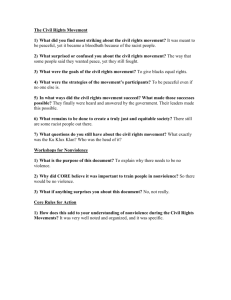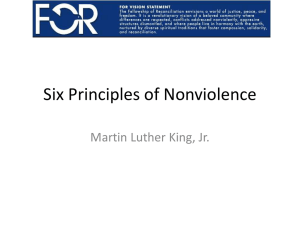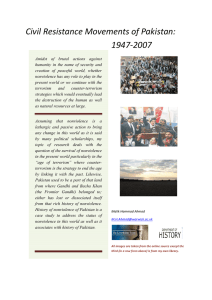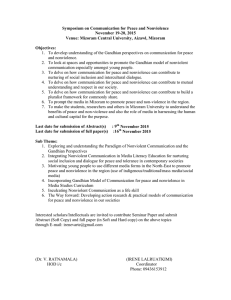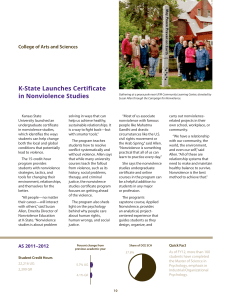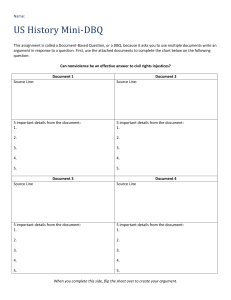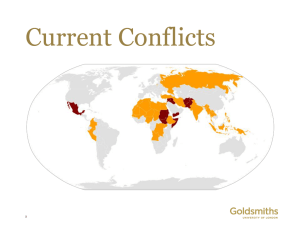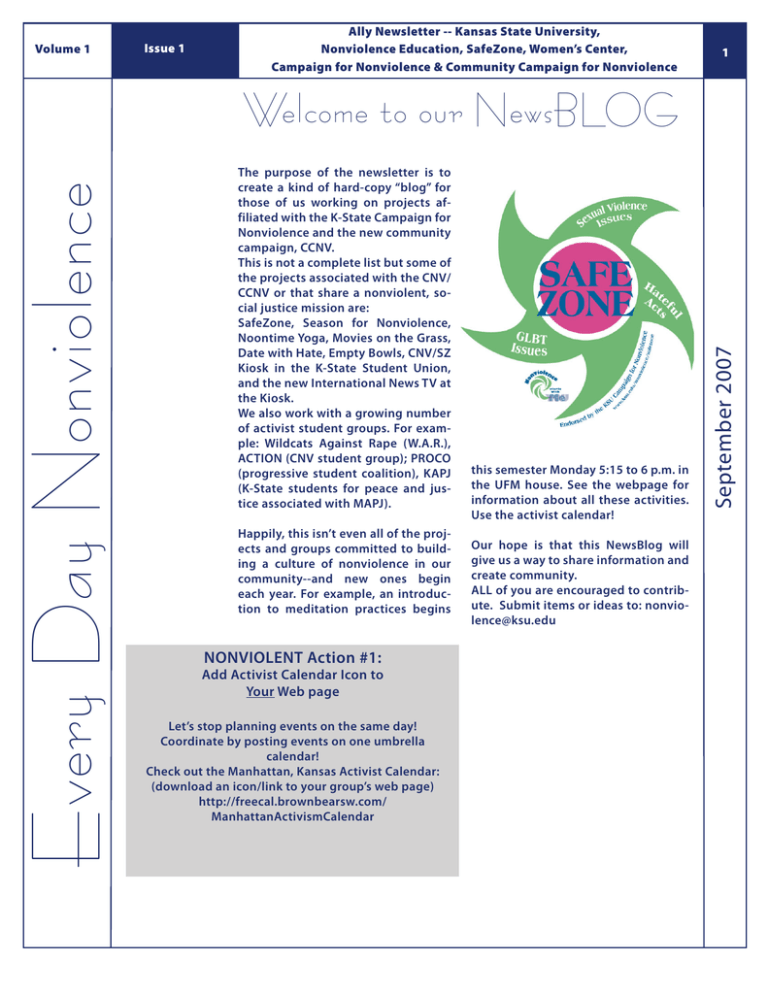
Volume 1
Issue 1
Ally Newsletter -- Kansas State University,
Nonviolence Education, SafeZone, Women’s Center,
Campaign for Nonviolence & Community Campaign for Nonviolence
The purpose of the newsletter is to
create a kind of hard-copy “blog” for
those of us working on projects affiliated with the K-State Campaign for
Nonviolence and the new community
campaign, CCNV.
This is not a complete list but some of
the projects associated with the CNV/
CCNV or that share a nonviolent, social justice mission are:
SafeZone, Season for Nonviolence,
Noontime Yoga, Movies on the Grass,
Date with Hate, Empty Bowls, CNV/SZ
Kiosk in the K-State Student Union,
and the new International News TV at
the Kiosk.
We also work with a growing number
of activist student groups. For example: Wildcats Against Rape (W.A.R.),
ACTION (CNV student group); PROCO
(progressive student coalition), KAPJ
(K-State students for peace and justice associated with MAPJ).
Happily, this isn’t even all of the projects and groups committed to building a culture of nonviolence in our
community--and new ones begin
each year. For example, an introduction to meditation practices begins
NONVIOLENT Action #1:
Add Activist Calendar Icon to
Your Web page
Let’s stop planning events on the same day!
Coordinate by posting events on one umbrella
calendar!
Check out the Manhattan, Kansas Activist Calendar:
(download an icon/link to your group’s web page)
http://freecal.brownbearsw.com/
ManhattanActivismCalendar
this semester Monday 5:15 to 6 p.m. in
the UFM house. See the webpage for
information about all these activities.
Use the activist calendar!
Our hope is that this NewsBlog will
give us a way to share information and
create community.
ALL of you are encouraged to contribute. Submit items or ideas to: nonviolence@ksu.edu
September 2007
Every Day Nonviolence
Welcome to our NewsBLOG
Ed et prat dunt loreet vendreril eugiamet wis nostrud tis ea facip
S
afe Zone is...
K-State students, faculty and staff
want to provide a safe and equitable
environment for every member of our
community. The SAFEZONE program
(Students, Administrators and Faculty for
Equality) was created to easily identify
and train persons, programs, and services
who will make a commitment to enhancing the quality of the K-State environment.
A
im: The purpose of the SAFE ZONE
program is to provide campus “safe
zones” where individuals affected by homophobia, sexual violence and other
kinds of hateful acts can safely go for support and assistance.
F
SafeZone
riendly Face: We don’t ask allies to become therapists; rather we help them
understand the nature of the problems
faced by citizens of our community; we
teach listening skills; and we provide
them with current resources. And we have
some fun along the way.
Duis #0
New Faces, Places, Jobs
To help manage the growing array of nonviolence projects in our community, several
changes have occurred at K-State. Susan
Allen, director of the K-State Women’s Center
since 1996, was appointed Director for Nonviolence Education. Mary Todd, advocate and
assistant director for the past five years, was
promoted to Director of the K-State Women’s
Center. Dori Lambert, clinical director of KState’s Counseling Services and chair for the
K-State Campaign for Nonviolence, has taken
the reins of K-State’s SafeZone program.
We have a half-time position open now for
a graduate student Social Justice Projects
Coordinator.
What that means to K-State and to the community is more nonviolence education
projects. And, as we are volunteer driven, it
means more opportunities to be involved.
asy Access to Help: By placing the SAFE
ZONE symbol on their office door, desk,
or backpack, SAFE ZONE allies signify that
their space is a safe place to talk about issues which impact people who have been
affected by any criminal or distressing
situation.
To facilitate that:
The new Nonviolence Education program,
CNV and a new Community Campaign for
Nonviolence (CCNV), and the Social Justice
Projects Coordinator have a new office in the
UFM House with easy access. Thanks to Linda
Teener and the UFM Board we are using an
office next to the Multi-Purpose room just
inside the alley door of UFM.
S
In the mornings, NV Education, Women’s Center, W.A.R. (Wildcats Against Rape), CNV and
its student group, ACTION share the office.
E
PONSORS: The Campaign for Nonviolence (CNV/CCNV) in conjunction with
the Women’s Center, the Queer-Straight
Alliance, the Office of Student Life, the
Counseling Services, the Office of Affirmative Action and the KSU Faculty/Staff GLBT
Group.
T
raining: We offer introductory and advanced training for K-State students,
faculty and staff several times each semester. To date, we have trained over 450 SafeZone allies on the K-State campus and this
year we helped the local High School start
as Safezone program. Individuals who are
interested in becoming SAFEZONE allies
or starting a program in another setting
can call 532-6444 or .go to www.ksu.edu/
womenscenter and click on SafeZone.
Illum 0000
In the afternoons, campus and area progressive groups will use the office. The idea is to
link a student group with a parallel community group so bridges can be built and nonviolence/social justice projects undertaken
collaboratively.
Mondays: a new network of progressive ministers (mostly from historical “peace churches”) will share the office and collaborate on
community/campus projects. For example,
they will sponsor a new Meditation Practices
Every Day Nonviolence
3
session this fall: Mondays between 5 and 6
p.m. Tuesday: K-State Alliance for Peace and
Justice (KAPJ and MAPJ. Wednesdays: Campus and off-campus SafeZone projects
Thursdays: Progressive Student Coalition
(PROCO) which includes several groups such
as Students for Environmental Action and
Amnesty International.
Fridays: Queer Straight Alliance (QSA), Flint
Hills Human Rights Coalition and community Pflag, have been invited to use the space.
We are doing the paperwork to establish
the Community Campaign for Nonviolence,
Inc. (CCNV) as a counterpart to the K-State
Campaign for Nonviolence. Anyone interested in being involved - call us.
We will offer a “way” or two to practice
nonviolence in each Blog. If you are familiar with a good nonviolence method,
please tell us about it!
10 Tips To Promote Verbal Nonviolence
1. Spend some time each day quietly reflecting on how you would like to relate
to yourself and others.
2. Remember that all human beings have
the same needs.
3. Check your intentions to see if you
are as interested in others getting their
needs met as you are in meeting your
own.
4. Before asking someone to do something, check to see if you are making a
request or a demand.
5. Instead of saying what you don’t want
someone to do, say what you do want
the person to do.
K-State Arts & Sciences Approves
15-Hour Nonviolence Studies Certificate
An added piece of good nonviolence news is that on June 12 the K-State
Faculty Senate approved a 15-hour Nonviolence Studies Certificate Program. It will be
housed in the general education of the College of Arts & Sciences, making it available
to all undergraduate students. This formalizes the Introduction to NVS and Applied
NVS classes several of us - including Charlie
Perkins (retired psychology professor), Cia
Verschelden (Office of Assessment), Torry
Dickinson (Women’s Studies), Jacque Gibbons (Social Work), Dori Lambert, and Susan
Allen - have been teaching since 2003.
6. Instead of saying what you want someone to be, say what action you’d like that
person to take.
7. Before agreeing or disagreeing with
anyone’s opinions, try to tune in to what
the person is feeling and needing.
8. Instead of saying “no,” look at what
need of yours prevents you from saying
“yes.”
9. If you are feeling upset, think about
what need of yours is not being met.
What could you do to meet it, rather than
thinking about what’s wrong with others
or yourself?
10. Instead of praising someone who
does something you like, express your
gratitude by telling the person what
need of yours that action meets.
Nonviolent Communication, Marshall B. Rosenberg, 2003
Ways to Practice Nonviolence
Every Day Nonviolence
Ways to Practice Nonviolence, Every Day
Community
Nonviolence Studies
Certificate
Targeted Guest teaching:
violence prevention and NV
awareness
research,
"Strength is not for Hurting"
Poster campaign
Rape prevention videos
Bathroom stalls campaign
Regular columns, ads
Provides videos,
presentations, and
educational materials to both
on and off campus groups
Counting the violence
Targeted training in
Violence prevention and NV awareness:
Orientation
Staff
Pan Hellenic
Faculty
Athletes
Community
Manhattan Middle Schools
Kansas Professionals (Principals/Counselors )
Sexual
violence
advocacy
PEERS: Proactive
educators for the
elimination of rape
and sexual assault—
5th year
Research
Global Social Justice - practicum, internship,
Applied NV Studies—2nd year
Introduction to Nonviolence
Studies—4th year
Local NV
Action,
applied
projects
Academics
Nonviolence Studies Program
2000 - 2005
CNV
Service w/ Violence
1973-1999
prevention; NV edu
(then wc/cnv)
WC
Intrapersonal
Interpersonal
Community
Global
self/universe
humans/earth
Holistic Levels -- for
thnking & actions:
Media
Campus/Community
Collaboration
Diversity
Holistic Perspectives
Integrated
Throughout:
Duis #0
Every Day Nonviolence
-FOR Peacemaker -White Privilege
-Media Reform -Gandhi NV Conference
Live Theater:
& classes:
Theater for
Conflict Res;
Nonfiction
play writing...
Student Groups:
ACTION, PEERS, ProCO
Noontime
Yoga
nonviolence as
organizing
principle
Applied Culture
Change w/
Media
e.g. Snyder video
64 ways CD
Webpages
Films
Conflict resolution/
Bookmark Outreach
Ed et prat dunt loreet vendreril eugiamet wis nostrud tis ea facip
National Trainings
-L.A. Season
-NV Communication
-So. Pov. Law Center..]]
National Speakers
Community-wide projects
64 ways education (poster,
shirts, CD)
Empty Bowls
Hale Library NV movies
Public Library displays
Annual Community Walk
National Leadership
Trainings
A Season for Nonviolencefive years - "64 days"
multi-level programming
CNV Rally
Awareness, info,
collaboration:
Campus,
Community,
Ft. Riley
KSU Kiosk - SafeZone
w/International news
NV Education
Violence Prevention
SafeZone: KSU f/s/s trained in
prevention and response w/NV
concepts (300+ by 2005)
Allies = safe,
accessible
reporting; begin
geometric growth of
NV education w/
facilitation by
allies throughout
university &
community
Campaign For Nonviolence -- Description Of Initial Five-Year Growth
CNV Five-Year Growth
4
Illum 0000
Nonviolence Studies at Kansas State University
We use the word “nonviolence” in our work
at Kansas State as a way to say three main
things:
* citizens of this community want to live in
a safe, fair environment;
* we understand that the global nonviolence movement axiom, “if we want peace,
we need to work for justice” translates locally, “if we want a safe campus (or dating
relationship or any other relationship) we
need to do the ongoing work of creating fair
relationships at all levels;
* and, furthermore, we are willing to step
up to “be the change we wish to see in the
world,” every day.
Nonviolence is about culture change and
involves changing our minds about how
we attend to conflict. Like the nonviolence
movement, in general, the Campaign for
Nonviolence and other Nonviolence Education efforts at K-State work to change the
organizational principle of this university
FROM one where we ignore the little and
big injustices, abuses of power and other
precursors to violence and system breakdown; and move it TO one where we organize around the principle of “getting ahead
of the violence”; where we “go upstream”
and attend to the imbalances and precursors to violence so we can prevent it.
By inventing, adapting and applying nonviolence strategies, tactics and tools, we can
attend to conflict before the crisis instead
of waiting for a crisis before we act. Keys to
the practice of nonviolence include learning to see problems as imbalances within
the context of whole systems; learning to
recognize conflict patterns and identifying
precursors to potential violence; and then
talking about them in the open and managing them while they are at earlier stages in
their development. Nonviolence methods
and expectations help us create strategies
and practical “ways” to practice nonviolence
(i.e. create healthy balance) at the local, personal level as well as the global level.
Do we need a Nonviolence Movement
at K-State?
One example: the U.S. Department of
Justice statistics say 412 rapes occur on a
campus the size of K-State in any given year.
Advocates have no reason to think that not
the case here.
For the sake of argument, let’s pretend our
community does not deny this startling
statistic. Let’s say 412 reports are made, 412
perpetrators are apprehended and sentenced, and that 412 lives are restored to
health.
The question is ...What do we do next year
- and the next? Do we follow custom and
wait for the next 412 rapes to occur? Or...
do we face the fact that violence happens;
that both perpetrators and the victims are
not aberrations but, rather that they are our
brothers and neighbors and ourselves? Are
we ready to see that safety and fairness are
inextricably linked and that it is up to us to
step up and amend the injustices before the
violence?
The question that will determine the safety
and wholeness or our lives in the 21st
century is this: “can human beings change
our collective mind about how we attend
to violence and crisis?” Will we continue to
react simplistically, with short-term BandAid fixes; or can we learn to reframe these
seemingly individual acts of violence within
the context of the whole system so we can
work to end the cycle of violence?
Why we use the term Nonviolence
Every Day Nonviolence
Why do we use the term “Nonviolence” at K-State?
Ed et prat dunt loreet vendreril eugiamet wis nostrud tis ea facip
Duis #0
Why we use the term Nonviolence
The nonviolence movement in general
works to help us change our minds about
how we deal with violence in ourselves
and our community. It’s aim is to prevent
violence by divising practical nonviolent
ways and means to restore balance to an
unhealthy, unjust relationship.
The “Every Day Nonviolence” we try to
practice at K-State is a philosophy as well
as a methodology for recognizing problems
within the context of whole systems, identifying patterns and precursors, and then
stepping up to attend to problems which, if
corrected at an earlier stage in their development, can prevent a crisis. Problems do
not appear from the clear blue sky; there
always will be one or more interconnected
precursors that will lead to violence if left
unresolved. Nonviolence strategies, tactics
and tools are designed to help us recognize
and act on problems at earlier stages along
the continuum of their development.
“Ways” to practice nonviolence are infinite
because every situation is unique. Always,
however, the goal is to apply nonviolent
ways of bringing better balance to a dysfunctional system, hopefully before the
crisis but afterwords, too, through conflict
resolution and forms of nonviolent direct
action. The means we use to address conflict will parallel the ends achieved so if we
want a system/relationship to last, nonviolence is the only option.
Babysitting for a friend can be a nonviolent
action. Cleaning up a stream is a nonviolent
action. Working for economic opportunity
for all citizens is a category full of potential
nonviolent actions. Taking a nonviolent
communication seminar with your partner
is a nonviolent action. Learning yoga or
long distance running for stress relief is a
nonviolent action. Treating employees, students, family, and friends fairly is a nonviolent action.
Nonviolence tactics, tools and strategies
are new to all of us because we all have
been taught the black or white, you-arewith-me-or-against-me, model of problem
solving. Nonviolence goes beyond traditional “prevention” efforts by asking average citizens to step up and take personal
responsibility for our shared environment
rather than waiting for the crisis and then
leaving problems to professionals.
Our most famous nonviolence advocate,
Mahatma Gandhi, said people “must be
the change we wish to see in the world.”
By this, he meant we could no longer leave
fairness and safety to the professionals;
that if we want safety, we work for fairness;
if we want peace we work for justice. Every
Day.
Read More About It: www.ksu.edu/womenscenter/nonviolenceworks
(From “412 and Nonviolence,” c Susan l. Allen 2006)
Illum 0000
Every Day Nonviolence
Maybe it was the anti-war fervor of the Vietnam era that created bad feelings about
“peace and nonviolence” movements. Whatever its cause, in order to have a successful
Campaign for Nonviolence (CNV) on campus
and viable new Community Campaign for
Nonviolence (CCNV) in our community, it
is important to acknowledge that some people are leery about the word “nonviolence.”
Part of the problem is no one knows for sure
what “nonviolence” means... Will it offend
military family and friends if I work on a CNV
or CCNV project? Does it imply I oppose U.S.
policies? Unfortunately, conversation about
peace and war
-- like all issues framed as “either/or” polarities -- use extreme language that makes us
feel forced to choose between opposing
camps.
In fact, one of the reason we’ve adopted nonviolence as a strategy to prevent violence is
that an important goal of the nonviolence
movement is to say there are alternatives
between the extremes. Nonviolence seek a
“third way,” which actually means any number of ways and means to proceed between
or beyond extremes like fight or flight, active
or passive, good or evil.
Nonviolence asks us to take a mental and
even physical step back from the conflict
so we can see the continuum of options between extremes and the spectrum of influences surrounding problems -- one or some
of which will be precursors to violence. Then,
the aim is to undertake nonviolent actions
that will help avoid crisis and violence.
Another difficulty with the word “nonviolence” is that, in English, it appears only to
be negative -- not violence, and/or against
something rather than “for” something. Many
people associate nonviolence with “passivity,” “pacifism”; they think it means being a
coward or being opposed to defending ourselves from someone else’s violence.
To the contrary, nonviolent methods are not
passive, they are active. They do not oppose
protecting oneself, rather they invite citizens to stop waiting for the crisis and leaving
(what is by then serious) conflict to professionals and, instead, to step up using nonviolent methods to help “be the change we
wish to see in the world” while conflict is in a
more manageable stage. Nonviolent methods often require great courage, as those
who faced the tanks in Tinneman Square or
the dogs in Selma can attest.
What nonviolence theory asks us to realize
is that violence leads only to more violence
and, therefore, never resolves the underlying problems that led to conflict. Thus, for
practical, outcome-based reasons, alone,
nonviolent methods are the only way to resolve conflict in ways make relationships
(between spouses or countries) sustainable.
Nonviolence theory argues further that nonviolence, as a way of responding to conflict,
actually is a “force more powerful” than violence. (Allen, 2007)
(For more about this topic, go to
www.ksu.edu/nonviolence)
The Word Nonviolence
Every Day Nonviolence
The Word Nonviolence
www.k-state.edu/womenscenter/SafeZone.htm
Ed et prat dunt loreet vendreril eugiamet wis nostrud tis ea facip
Duis #0
SafeZone Registration ( View training dates and register)
View K-State Campus Map and location of Allies
SafeZone Allies on campus (View SafeZone Directory)
SafeZone Supporters and Resources
Campaign for Nonviolence
K-State wants to provide a safe and equitable environment
for every member of our community. The SAFE ZONE program (Students, Administrators and Faculty for Equality) was
created to easily identify persons, programs, and services that
have made a special commitment to enhancing the quality of
the K-State environment.
PURPOSE:
The purpose of the SAFE ZONE program is to provide campus “safe zones” where individuals affected by homophobia,
hateful acts, & sexual violence can safely go for support and
assistance. By placing the SAFE ZONE symbol on their office
door, desk, or backpack, SAFE ZONE allies signify that their
space is a safe place to talk about issues which impact people
who have been affected by any type of hateful or homophobic act, or who have been affected by sexual violence, sexual
harassment, or any criminal or distressing situation.
SPONSORS:
The Campaign for Nonviolence (CNV) in conjunction with
the Women’s Center, the Queer-Straight Alliance, the Office
of Student Life, the Counseling Services, the Office of Affirmative Action and the KSU Faculty/Staff GLBT Group offer
training for individuals who are interested in becoming SAFE
ZONE allies.
TRAINING/INFORMATION:
To view training dates and to register click on Safe Zone Registration
Illum 0000

